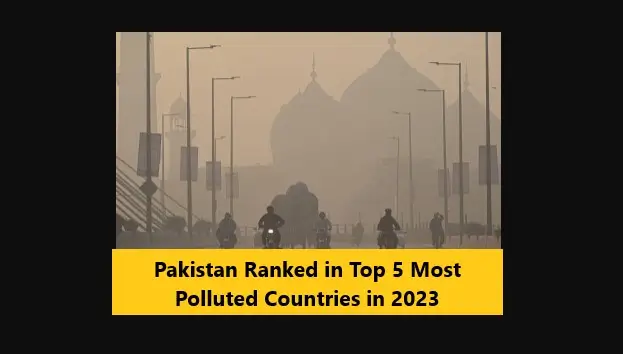Pakistan Ranked in Top 5 Most Polluted Countries.
Pakistan Struggles with Air Pollution: Ranked Second Most Polluted Country in 2023
A concerning report by IQAir, the air quality watchdog, reveals a grim reality for Pakistan.
Read More: Death Toll from Pneumonia Spikes to 456 in Punjab
According to the 6th Annual World Air Quality Report released in 2024, Pakistan is the second-most polluted country globally, following only Bangladesh. This highlights the significant challenges Pakistan faces in terms of air quality and its impact on public health.
Data-Driven Analysis: Exposing the Problem
The report presents a comprehensive analysis based on data collected from over 30,000 air quality monitoring stations across the globe. This data paints a clear picture of Pakistan’s air pollution crisis:
- Average PM2.5 Concentration: Pakistan’s average PM2.5 concentration in 2023 was a staggering 73.7 micrograms per cubic meter (μg/m³).
- WHO Guideline Exceeded: This value is more than 14 times higher than the World Health Organization’s (WHO) annual PM2.5 guideline of 5 μg/m³.
Global Comparison: Not Alone, But Urgent Action Needed
While Pakistan’s situation is alarming, the report also reveals air pollution is a global issue:
- Top Polluted Countries: Bangladesh, India, Tajikistan, and Burkina Faso join Pakistan in the top five most polluted countries.
- Global Trend: A staggering 124 out of 134 countries (92.5%) exceeded the WHO’s annual PM2.5 guideline.
Health Risks and Consequences
The report doesn’t explicitly mention the health risks associated with air pollution, but the high PM2.5 levels indicate a severe threat to public health. PM2.5 refers to fine particulate matter, microscopic particles that can penetrate deep into the lungs, causing respiratory problems, heart disease, and even cancer.
Possible Causes and Contributing Factors
The report identifies potential factors contributing to the high levels of air pollution in Pakistan and other regions:
- Climate Conditions: Seasonal changes and weather patterns can influence air quality.
- Transboundary Haze: Air pollution from neighboring countries can travel long distances, impacting air quality in Pakistan.
- Lack of Monitoring Data: Africa remains significantly underrepresented, highlighting the need for improved monitoring infrastructure globally.
Positive Developments and Solutions
While the report highlights the challenges, it also acknowledges positive developments:
- Increased Monitoring: The number of countries and regions with air quality monitoring has increased in recent years.
- Low-Cost Sensors: Citizen scientists and local organizations are playing a crucial role by deploying low-cost air quality monitors to fill data gaps.
Call to Action: Prioritizing Clean Air for a Healthier Pakistan
The report concludes with a powerful message: “A clean, healthy, and sustainable environment is a universal human right.” This statement underscores the urgency for Pakistan to prioritize air quality improvement. Potential solutions include:
- Strengthening Regulations: Implementing stricter regulations on industrial emissions and vehicle pollution.
- Promoting Renewable Energy: Transitioning to cleaner energy sources like solar and wind power.
- Urban Planning and Green Infrastructure: Developing sustainable urban planning policies and promoting green spaces in cities.
- Public Awareness Campaigns: Raising public awareness about the health risks of air pollution and encouraging behavior changes that reduce emissions.
By acknowledging the severity of the problem and taking decisive action, Pakistan can move towards a future with cleaner air and a healthier population.
Note: The information above might not be accepted 100%. Please verify from your own sources. We will not be responsible for any kind of loss due to our content.
For more news, please visit Munafa Marketing.




